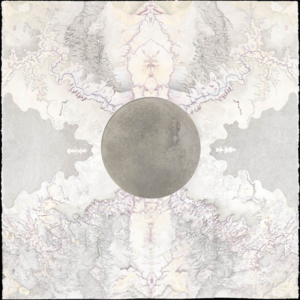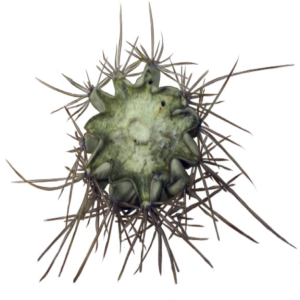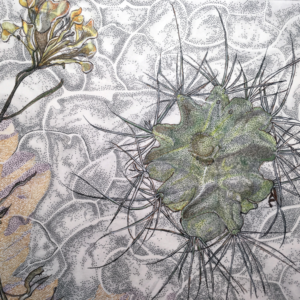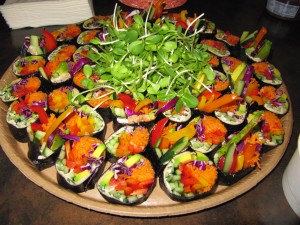Matthew Nienow’s House of Water
Farmington, ME: Alice James Books, 2016. 57 pages. $15.95.
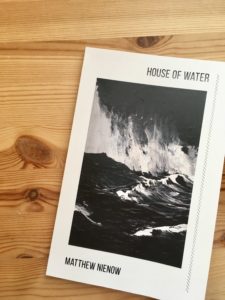 For the past few months I’ve been unmoored, I feel against everything. I think a lot of us do. During this time I’ve turned, as I always have in difficult times, to books. I’ve found myself drawn to two types of books, both of which seem relevant and necessary. The first kind are those that teach me to see through the eyes of others, show me the history of how we got here, give voice to the often unheard, teach me to resist, give me strength to fight back. The second type of book I’ve been drawn to are those which praise the physical world, look with wonder at the earth and its inhabitants, draw the eye to the light. The books of the first kind have been my maps and guides. The second kind of book has been an anchor for me. In these times of upheaval and uncertainty I am seeking things that ground me to the world, that re-invest me in this place. I want to hold something in my hands, to know that it is real, to remember I’m not against everything. The poems in Matthew Nienow’s House of Water are as close to that as poems can be.
For the past few months I’ve been unmoored, I feel against everything. I think a lot of us do. During this time I’ve turned, as I always have in difficult times, to books. I’ve found myself drawn to two types of books, both of which seem relevant and necessary. The first kind are those that teach me to see through the eyes of others, show me the history of how we got here, give voice to the often unheard, teach me to resist, give me strength to fight back. The second type of book I’ve been drawn to are those which praise the physical world, look with wonder at the earth and its inhabitants, draw the eye to the light. The books of the first kind have been my maps and guides. The second kind of book has been an anchor for me. In these times of upheaval and uncertainty I am seeking things that ground me to the world, that re-invest me in this place. I want to hold something in my hands, to know that it is real, to remember I’m not against everything. The poems in Matthew Nienow’s House of Water are as close to that as poems can be.
Built in to each of the poems in House of Water is a commitment to the physical world. Readers cannot escape the smell of seawater, the heat of fire, the shavings of wood beneath their feet, the laughter of children, or the rock of a boat. The book begins with a prayer to the tools of his trade (he builds boats) and continues with odes to those tools (“Ode to the Belt Sander & This Cocobolo Sapwood,” “Ode to the Steam Box,” “Ode to the Gain,” “Ode to the Preacher Jig,” “Ode to the Slick”), joy in the work of creation, and quiet moments of watching his wife and children. Nienow begins with the tools, but from there goes on to praise the body which uses the tools, the life that is created, and the work it all takes.
These poems are about learning to look closely at the things we hold daily. In Nienow’s case these things are tools and woods I’m unfamiliar with, but came to admire as I read through the book. In “Ode to the Belt Sander & This Cocobolo Sapwood” Nienow holds up a block of wood to the belt sander and:
A single knot blinks
out of the small block & becomes
the eye of a hummingbird, its beak
bending around the edge of the wood,
its song captured in the annular rings.
To think, this block was tossed in
with the scrap. That the bird
could have been lost. Or burned.
How quickly the mundane scrap of a day can become a thing to behold. The world still holds mystery and wonder. Sometimes that mystery is locked away in a block of wood, sometimes it is hidden in a page of scribbled notes waiting to become a poem. Nienow shows the reader how to hold a scrap in their hand, hold it to the light, and get to work uncovering its beauty.
At first glance “The Handshake” seems like a shout against the body and work:
God damn my hands
and the inward ache
that is the echo of every
hammer swing; God
damn every struck thing
and the impulse to make.
God damn the scars
and the memories they bear,
the fists I carry with me
everywhere; God damn
all that my hands fail
to hold…
But in the refrain of “God damn…” we hear the echo of “God bless.” Instead of reading of anger and resentment, the pain and shame of this poem become an ode all their own: to the hands (“my two best tools”) that long to create, that come from a long line of hands (“I remember / my father’s father”), and that get to shape their future:
I consider
the road. My handshake
will not tell you
what kind of man I am.
This poem is a reminder that we can howl against the pain in our lives and still hold our lives dear. We can see the darkness of the world and still want to make it brighter. Sometimes the very hands that hurt are the hands that will create something that gleams.
Halfway through the book, in “Song of Tomorrow,” the speaker wants to give the world, whole and shining, to his children: “I will give / them whatever I have, whatever I can acquire.” But he also knows he will not be able to give them all he desires to, he is “ a man trying / to hold water in cupped hands” knowing he “will fail / to hold it.” But even in that failing he knows “what joy there is in feeling it pass.” Throughout the book Nienow balances praise of the physical with the knowledge that it will never be enough. Nienow’s book is not a glossy ode to the perfect, but an ode to the scraped and dented imperfect life we create with our hands. There is joy not just in the material or the tools, but in the process of creation – the life we live.
By the time we get to “Making a Rabbet Plane in the Machine Shop on the Hill” we have praised the materials, the tools, and the process of creation, but here we watch the speaker work. The worker has to dig into his collection of tools with his aching hands and put them into action. In this collection of poems, the speaker is never more than a line or two away from work. Above all, the work is to be praised:
I turn
the idea of the tool over in my hands.
That it works makes me want to work.
The work, it carves that want away.
Nienow shows, through his writing, the work it takes to chisel, bend, and sand raw material down to a useful object and how that work itself is beautiful. When we look at the world there is endless wonder, but wonder alone won’t change anything, it takes work. This is not a book merely of ideas, but of tools, material, and what they create. Nienow finds beauty in the world because he works to make it.
We need things to tether us to this earth. We need to find reminders of the immensity and wonder this earth holds – it will give us the energy to move forward when it feels like we can’t. We need to create wonder of our own and to find joy and solace in the work of creating. As writers, this book is a reminder to stay observant and alert and curious in our work. And above all, to love the work.
Stand up, march, protest, yell, read to inform yourself, carry a sign, volunteer, donate. And when you get weary and start losing hope, recharge with a book that tethers you to this world. Because we have to stay invested in this place, in each other. Writers need to keep writing about the things that matter to them, sharing their stories because like the famous Maggie Smith poem, “Good Bones,” says: “This place could be beautiful, / right? You could make this place beautiful.” To work to make it beautiful, we have to remember it’s worth it.
More book recommendations for mooring you to this earth:
Bright Dead Things by Ada Limón
System of Ghosts by Lindsay Tigue
World of Made and Unmade by Jane Mead


